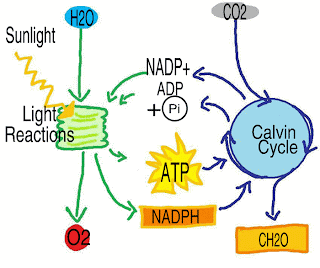Light Reaction
Chlorophyll captures light energy
> excites the electron
> electron leave the chlorophyll molecules
Light energy(Photolysis of Water)
> split water molecules into hydrogen/hydroxyl ions
> hydrogen ions combine with electrons(chlorophyll) to form hydrogen atoms
> energy from the excited electron is used to form ATP
> hydroxyl ions loses electron to form hydoxyl group
> hydroxyl group combine to form water/oxygen
> ATP provide energy and hydrogen atoms provide reducing power for dark reaction
Dark Reaction(Calvin Cycle)
> light independent
> hydrogen atom are used to fix carbon dioxide
> Result: reduction of carbon dioxide into glucose
> glucose undergo condensation to form starch
Equation
6 CO2 + 12 H2O + light energy --> C6H12O6 + 6 O2 + 6 H2OSchematic Diagram
Comparison Light and Dark Reaction
Light Reaction | Differences | Dark Reaction |
Photolytic reaction | Type of reaction | Series of bio-chemical reactions |
Day | Time of reaction | Day and night |
Grana | Site of reaction | Stroma |
Water | Substance required for reaction | Carbon dioxide |
Oxygen and water | Products of reaction | Glucose and water |
Occurs | Photolysis of water | Does not occur |
Required | Light energy | Not required |
Forms ATP and hydrogen atoms | ATP and hydrogen atoms | Uses ATP and hydrogen atoms |



0 comments:
Post a Comment